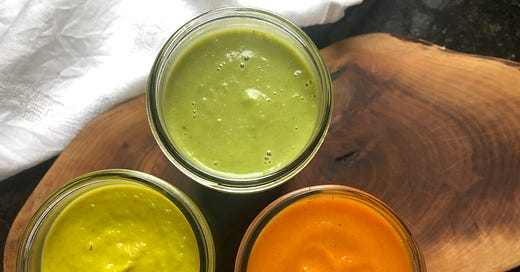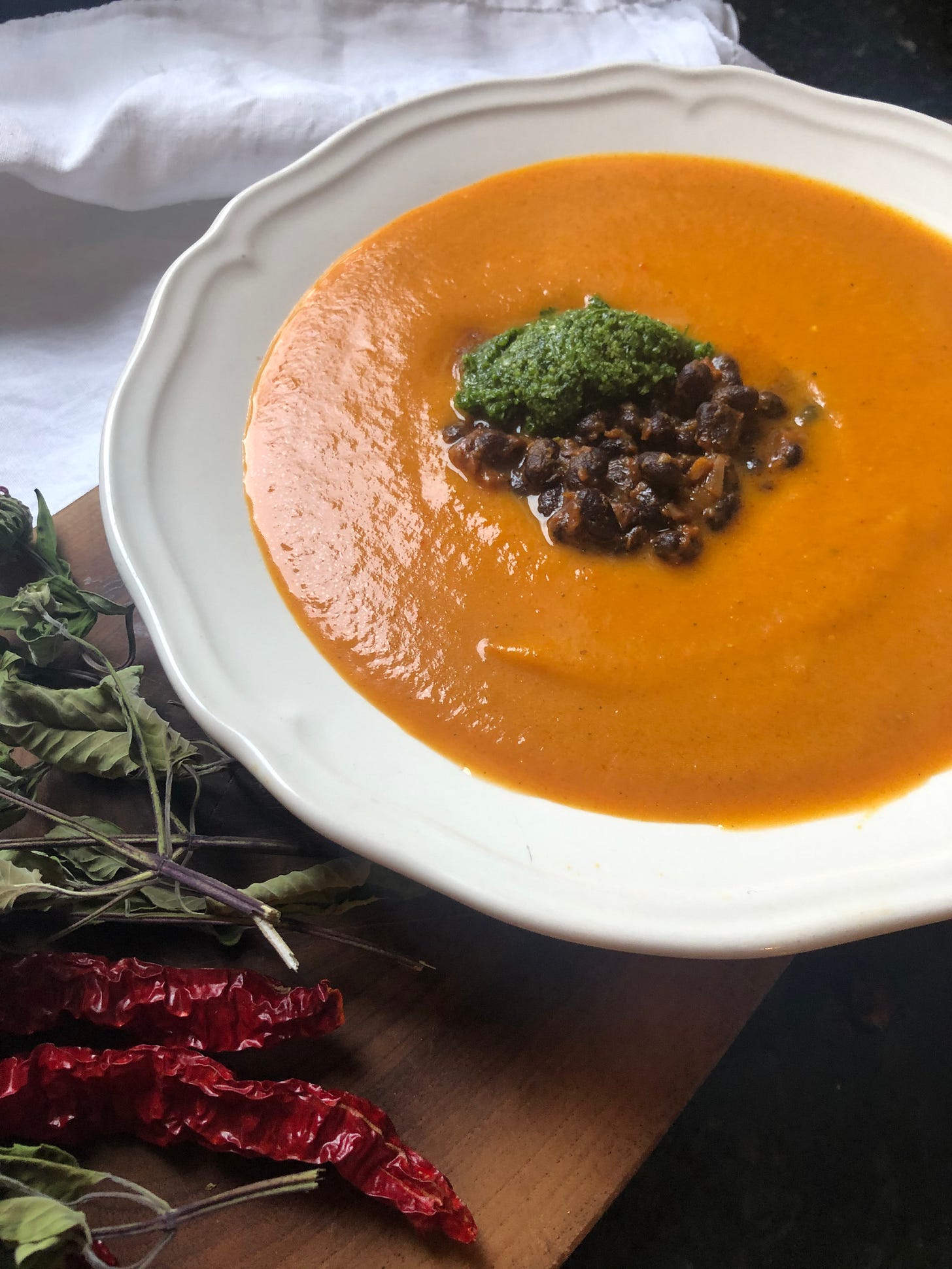Blended Soups and Savoury Smoothies
SAVOURY SMOOTHIES
I get it, some days are so busy - it feels like we don’t have time to chew our food, much less sit down and enjoy it. I understand why smoothies have become so popular. I have a few concerns about the traditional smoothie based on frozen fruit and yogurt - not only are they often consumed “on the run”, which does nothing to support our digestive function or nervous system balance, they are also COLD. Cold food is problematic for our digestive system. In Ayurvedic medicine, one of the most important functions to support in the body to ensure overall health is what’s called “agni”, or our digestive “fire”, so to speak. Cold food, frozen food, eating on the run all top the list for putting a damper on our digestive fire. If you want to support optimal health, rethink your idea of smoothies. Consider the concept of the savoury smoothie.
In the winter when the temperatures drop and our body needs more warming foods, I like to think of smoothies in terms of blended soups. Warm and savoury smoothies for a quick meal are great, especially in these colder winter months, when drinking icy fruit concoctions does not make sense. These blended soups are a great way to get more vegetables into your diet. You can enjoy a cup of this soup alongside your breakfast, as a warm nourishing snack, as part of a nutritious lunch or as a start to the dinner meal. With the addition of a handful of greens perhaps, and some extra protein it becomes a satisfying meal in and of itself. Check out this Chickpea Flatbread Recipe for a great soup accompaniment, or this Mexican Pumpkin Soup Recipe for some ideas on adding protein.
For tips on creating your own version of a savoury smoothie see the end of this article. It includes a run down on extra things to add to turn a simple blended soup into a super power smoothie. I am a fan of my blender which blends almost anything to a silky smooth texture. When blending these soups, blend them long enough to create the kind of texture that you enjoy
In the Mexican Pumpkin Soup shown above, the Chorizo Spiced Black Beans are optional. It’s a great example of how versatile a blended vegetable soup can be. Enjoy it as a savoury smoothie, or add some greens and extra protein and you’ve got a whole meal.
A FEW RECIPES FOR BLENDED VEGETABLE SOUPS
There is a lot of leeway when it comes to creating a blended vegetable soup. And it can be very simple - take a good quality broth or stock, throw in some vegetables, a few seasonings and blend. I will often use whatever I have on hand, and this may include some sort of leftovers in my fridge that I am wanting to use up. If you need more structure and want some creative ideas, here are recipes to get you started. Hopefully these will serve as a starting point to get you into the groove to create your own.
Clean Green Soup – I would sub in some other greens for the chard… just because I don’t like chard ;)
Escarole Soup – another soup based on green leafy vegetables including lettuce
Stinging Nettle Soup – this is a great spring tonic soup
Asparagus Soup – the parmesan is optional
Carrot Ginger Soup – You could sub sour cream or greek yogurt for the cashew cream
Creamy Parsnip Soup - with hazelnuts, cardamom and thyme
Butternut Squash Soup with Sage and Rosemary
BASIC TEMPLATE FOR A SAVOURY SMOOTHIE
The recipes listed above are a great starting point to get an idea of how a simple blended vegetable soup can taste good. Here is a run down of things that can be added to your blended soup to turn it into a super powered smoothies.
Broth or Stock
When making a savoury smoothie, I will cook the vegetables in the broth base - veggie, beef or chicken etc. If you don't have time or the inclination to make bone broth, there are quality powdered broth and stock products on the market.
Vegetables
Vegetable that are best cooked: asparagus, broccoli, cauliflower, carrots, zucchini, burdock root, leek, garlic, onion, greens, kale, collards, peas, celery, fennel, tomato, peppers, cabbage etc. Many of these vegetables can be cooked in the broth base and well-blended to create a smooth texture. Some of these veg are nice added at the end of blending, in order to maintain some texture - onions, carrots, mushrooms, celery, leek, cabbage, kale etc.
A generous handful of fresh herbs or greens - parsley, chervil, cilantro, cress, celery tops, lettuce etc
Fat
Choose from any of the following according to your body’s metabolic needs:
Avocado for added creaminess
Coconut oil, Ghee, Extra Virgin Olive Oil, Creme Fraiche, Organic heavy cream
Ground flax, hemp, chia seed, sesame seeds, sunflower seeds or pumpkin seeds for added fibre, creaminess and protein. Be careful as this can easily make the soup too thick and can get in the way of smooth mouth appeal if that’s a thing for you.
Protein
Make sure you are getting enough protein to meet your requirements. This is individual for everyone. If you are having a lot of food cravings, especially for carbs, or have a tendency to snack, especially later in the day, it can be very helpful to get enough protein with each meal, so add some to your smoothie. Options for protein may include:
Bone broth, quality bone broth powder or gelatin
Legumes - You can add this before or after blending, depending on if you want to keep some texture to it
Meat or Eggs - You can add this before or after blending, depending on if you want to keep some texture to it
Protein Powder - Unflavoured and unsweetened works best
Carbohydrate
If you need more carbs, savoury smoothies are a great way to get more of nature’s carbs into you. Consider the addition of:
Cooked starchy veg - potatoes, yams, squash, taro, cassava, parsnip, pumpkin, celery root etc
Cooked chickpeas, lentils or other legumes - added before or after blending according to texture
Leftover cooked oats, quinoa, millet, amaranth, barley etc
Support your Gut and Microbiome
Many of the ingredients in your soup are acting as a beneficial prebiotic to feed the beneficial gut bacteria - often in the form of fibre. You may also want to consider adding some sort of probiotic to your smoothies for extra support. In this case, add it at the very end and don’t overheat it, in order to preserve its aliveness. Choose from any of the following:
1 tablespoon of whey or the juice from naturally fermented sauerkraut or naturally fermented pickles
1-2 tablespoons of naturally fermented vegetables
A few tablespoons of kefir, unsweetened yogurt, coconut yogurt
Flavour to Appease your Tastebuds
We want our food to taste good, not only for enjoyment, but to optimize the digestive system’s response to what we are eating.
Add a quality salt to taste. Any a variety of herbs and spices according to your taste buds
Ginger, chiles, garlic or curry powder for a kick. Add some turmeric to increase the anti-inflammatory power of your soup. Turmeric is best if first heated together with a pinch of black pepper in a fat or oil base
Tomatoes add a nice tang. If you can't tolerate tomatoes, consider some adding in some fermented vegetables, tamarind, lemon, lime, or a bit of apple cider vinegar





